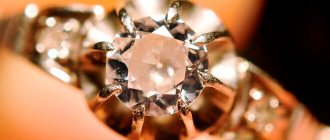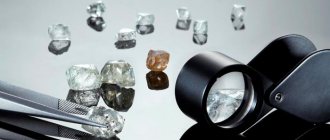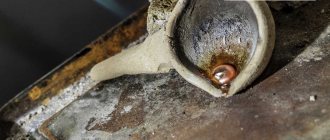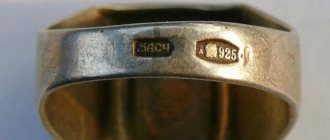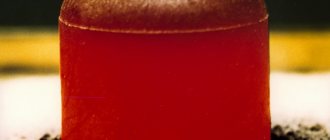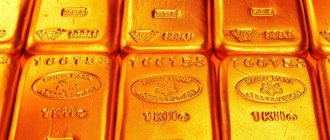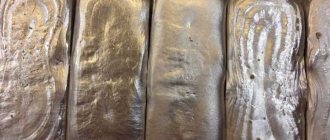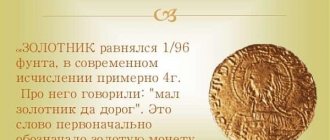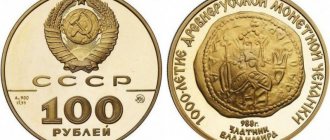Post updated: May 27, 2020
Gold is a fairly heavy metal with a high density of 19.32 g/cm3. According to this indicator, gold ranks 7th among all metals. Different systems have different units of measurement: SI = N\M3, MCSS = 1 kg\m3, SGS = 1 din\cm3. Also, the specific gravity of gold can be expressed in grams per cm3 (non-systemic unit).
Specific gravity, expressed in g/cm3, is equal to the density of a given metal. For gold, this figure is 19.3 g/cm3. The volumetric weight of gold is a calculated value that reflects the density of the metal.
- Weight and quality features of gold
- Basic physical and mechanical properties of gold
- Obtaining gold and its use
Metals with similar specific gravity values
There are several metals in nature that have a density similar to gold. These are uranium and tungsten. Uranium will not be used to counterfeit gold for two reasons: firstly, it is radioactive, and secondly, it is not so easy to get. Tungsten is much more suitable for this. But tungsten also differs from gold in hardness and color, which does not allow it to be passed off as gold.
Counterfeiters do things differently. Tungsten ingots are coated with gold on top. But it's not just fake bars that are made this way. It is also used to make gold-plated jewelry. Externally, such products look the same as the real ones, but have different wear resistance characteristics and, accordingly, price. There are also simply tungsten products; they are popular among young people.
Read also: How to properly use polyurethane foam without a gun
Jewelry made from lead, which has a soft structure, is also coated with gold. There is an opinion that lead can be easily distinguished by density or specific gravity, since this indicator is very different for gold. But that's not true. Gold is not used to make jewelry in its pure form, only in alloys.
In different alloys, the density of the product can vary, so products made of lead and 375 gold of the same size can weigh the same. Gold of other samples has a much higher density, with the exception of the rarely used 333 and the popular 417 in the West. The common 585 sample has a specific gravity of 15-16 g per centimeter cubed, which is significantly heavier than lead.
The density of gold is a very important indicator that is important in its mining, jewelry production, and refining. Determining the density can help distinguish a real product from a fake one, of course, if there is no sample on it, however, the sample can also be faked. This indicator is also important in research aimed at discovering new colors of metal.
Very often you can find jewelry with unusual colors; often these are sprayed, but alloys that have a rare color are especially valued. The production of such alloys is complicated precisely by the difference in melting temperatures and densities of the metals that must be added to gold to obtain a certain color.
If you are going to print counterfeit dollars, you must have special paper, otherwise the bills will not look real and can be easily detected by special pens that are used by merchants and banks around the world. If you are going to counterfeit gold bars, you must be sure that they have the same weight and other properties of real gold. In early 2008, millions of gold dollars in the Central Bank of Ethiopia turned out to be fake. What was thought to be real gold bars turned out to be gold-plated steel. Ethiopia tried to sell these “products” to South Africa, but they were sent back because South African experts discovered they were fake. The problem with making good quality counterfeit gold is that gold has a high density. It is almost twice the density of lead and two and a half times the density of steel. We don't usually notice this because small gold pieces don't weigh enough to make the difference obvious, but if you've ever held a standard 12-plus kg gold bar, it's hard to miss: the bar is very heavy. A GLD compliant interbank gold bar weighs approximately 400 ounces (approximately 12.44 kg). A steel ingot of the same size weighs just over 6 kg. There are only two metals that have a density close to gold. The first is depleted uranium, which is cheap if you're a government, but unaffordable for individuals. In addition, uranium is radioactive, which is an additional problem. The second is a real candidate for counterfeiting: tungsten. Tungsten is significantly cheaper than gold (about $30 per kg of 99% pure metal, compared to more than $35,000 per kg of gold). And, remarkably, it has the same density as gold - 19.3 g/cc, accurate to the third decimal place. The main differences are that it is gray in color and that tungsten is much harder than gold (only diamond is harder than tungsten - approx. M.T.). The softness of pure gold is so great that it can be scratched with a fingernail. A high-quality counterfeit gold bar must fully match the color, surface hardness, density, chemical and physical properties of gold. To create this, take a tungsten ingot 1/8 inch (3.17 mm) shorter in every dimension than a GLD bar, place it in a melt of pure gold, so that each gold facet ends up being 1/16 inch thick (about 1 .6 mm). The finished bar will look very natural, it will have the same thud when struck as a real bar, it will weigh exactly the same, and although this is not known for sure, a 1/16 inch layer of pure gold plating will be enough to prevent the X-ray machine from detecting tungsten. You have to drill through the ingot to find out that it is a fake. It costs approximately $50,000 to produce such a high quality counterfeit GLD bar because it contains natural gold, but the sale would still make a significant profit considering that the natural bar costs about $400,000.
Read also: Contactor designation on a single-line diagram
Category: question-answer
How to determine the weight of a gold ring if there are no scales?
Expert opinion
Grishanov Mikhail Petrovich
Jeweler, director of the Grishanov and Co. workshop
You can determine it in different ways, one of them is to go to a jeweler. However, there are 4 ways to help determine the weight of jewelry yourself: compare it with another product of the same standard, using a glass of water, use the experience of Asian traders, or a homemade device using a spacer and a ruler.
Will the weight of gold be accurate on a kitchen scale?
Expert opinion
Pribrezhny Gennady Valentinovich
Jeweler 6th category
Professional jewelers use electronic scales with small errors. Home kitchen ones cannot boast of such accuracy, although they are more accurate than floor-mounted ones.
How much does 1 kg of gold cost in Kazakhstan?
1 Gold ounce = 775,167.97 Kazakhstani tenge
| Golden Block | Gold price in Kazakhstan tenge (KZT) | Gold price in US dollars (USD) |
| 1 kilogram of gold | 24,925,015.05 | 58,388.13 |
| 1 gram of gold karat 24 | 24,925.02 | 58.39 |
| 1 gram of gold carat 22 | 22,847.93 | 53.52 |
| 1 gram of gold carat 21 | 21,809.39 | 51.09 |
Basic physical and mechanical properties of gold
In addition to specific gravity, the physical and mechanical properties of gold are also important characteristics.
Color. According to this indicator, of all the metals, only gold (yellow) and copper (pinkish-red) have their own special, characteristic color. As for other metals, it is more complicated - for example, white color is characteristic of platinum, silver, aluminum, tin, magnesium and cadmium. In addition, some metals can have different shades - arsenic (grayish), lead (bluish-white). Many metals, when crushed, may have uncharacteristic colors, such as red or brown. In addition, most metals oxidize upon prolonged contact with air and, as a result, they darken.
Specific gravity plays an important role not only in gold mining, but also in the production of various alloys. In order for them to be uniform and of high quality, it is necessary to select metals with a slight difference in specific gravity. Otherwise, if the difference is very significant, during fusion the metal, which has a lower volumetric weight than gold, may float.
Only gold and copper of all metals have a special, characteristic and unique color.
Gold turns into a liquid state from a solid at 1095 degrees Celsius.
Specific heat. Denotes the amount of heat that is necessary to increase 1 kilogram of gold by 1 degree Celsius - measured in kilocalories and denoted by the letter C.
Thermal conductivity. This property of a metal to conduct heat is characterized by its thermal conductivity coefficient.
Gold melts at 1095 degrees Celsius.
Hidden melting point. The metal must be heated to the melting temperature and maintained while the crystalline structure is destroyed - until the gold completely transforms into a liquid state. This additional energy is called the latent heat of fusion and is measured in kilocalories.
Electrical resistance - measured in Ohms.
Coefficient of linear expansion (thermal or thermal). Indicates the ability of a metal to increase its size in length (when heated).
Magnetic properties. All metals are divided into: paramagnetic, diamagnetic and pheromagnetic. When introduced into a magnetic field, materials of the diamagnetic group are not attracted to the magnet. Gold is one of the diamagnetic metals.
Types of ingots
There are several types of ingot standards, which have different applications and technologies. According to the method of application, they are divided into the following:
- measured;
- standard.
gold bars
are intended for sale to citizens, standard ones are used only for technological needs. According to production technology, there are several types:
- stamped;
- powder;
- cast.
The designation of stamped ones is SZSh, their weight does not exceed half a kilogram, they can easily be lifted with just your fingers. When stamping, they are cut from flat sheets. Powder ingots are made using the electrolytic method, and metal powders are used for their production. They are not used in the Russian Federation. They are the cheapest and are also rarely used by banks in other countries.
Ingots that are made by casting have a large mass and will be difficult to lift with your fingers. Cast bricks weigh more than 500 grams, they are designated SLZ. The price ranges between powder and stamped. If the product does not meet the requirements of GOST, then it is sent to the manufacturer for re-melting. Most of them must comply with the requirements of the London Bullion Market Association.
